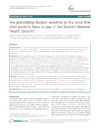Please use this identifier to cite or link to this item:
https://accedacris.ulpgc.es/jspui/handle/10553/7226
| Title: | Are prescribing doctors sensitive to the price that their patients have to pay in the Spanish National Health System? | Authors: | González Lopez-Valcarcel, Beatriz Librero, Julián Sanfélix-Gimeno, Gabriel Peiró, Salvador |
UNESCO Clasification: | 32 Ciencias médicas | Keywords: | Average Price National Health System Price Differential Autonomous Community Therapeutic Group |
Issue Date: | 2011 | Project: | PI 06/90515 PI07/90608 |
Journal: | BMC Health Services Research | Abstract: | Background This study aims to design an empirical test on the sensitivity of the prescribing doctors to the price afforded for the patient, and to apply it to the population data of primary care dispensations for cardiovascular disease and mental illness in the Spanish National Health System (NHS). Implications for drug policies are discussed. Methods We used population data of 17 therapeutic groups of cardiovascular and mental illness drugs aggregated by health areas to obtain 1424 observations ((8 cardiovascular groups * 70 areas) + (9 psychotropics groups * 96 areas)). All drugs are free for pensioners. For non-pensioner patients 10 of the 17 therapeutic groups have a reduced copayment (RC) status of only 10% of the price with a ceiling of €2.64 per pack, while the remaining 7 groups have a full copayment (FC) rate of 40%. Differences in the average price among dispensations for pensioners and non-pensioners were modelled with multilevel regression models to test the following hypothesis: 1) in FC drugs there is a significant positive difference between the average prices of drugs prescribed to pensioners and non-pensioners; 2) in RC drugs there is no significant price differential between pensioner and non-pensioner patients; 3) the price differential of FC drugs prescribed to pensioners and non-pensioners is greater the higher the price of the drugs. Results The average monthly price of dispensations to pensioners and non-pensioners does not differ for RC drugs, but for FC drugs pensioners get more expensive dispensations than non-pensioners (estimated difference of €9.74 by DDD and month). There is a positive and significant effect of the drug price on the differential price between pensioners and non-pensioners. For FC drugs, each additional euro of the drug price increases the differential by nearly half a euro (0.492). We did not find any significant differences in the intensity of the price effect among FC therapeutic groups. Conclusions Doctors working in the Spanish NHS seem to be sensitive to the price that can be afforded by patients when they fill in prescriptions, although alternative hypothesis could also explain the results found. | URI: | https://accedacris.ulpgc.es/handle/10553/7226 | ISSN: | 1472-6963 | Other Identifiers: | http://dx.doi.org/10.1186/1472-6963-11-333 | DOI: | 10.1186/1472-6963-11-333 | Source: | BMC Health Services Research [EISSN 1472-6963], v. 11, 333, (Diciembre 2011) |
| Appears in Collections: | Artículos |
SCOPUSTM
Citations
8
checked on Jun 8, 2025
WEB OF SCIENCETM
Citations
7
checked on Jun 8, 2025
Page view(s)
233
checked on Nov 1, 2024
Download(s)
267
checked on Nov 1, 2024
Google ScholarTM
Check
Altmetric
Share
Export metadata
Items in accedaCRIS are protected by copyright, with all rights reserved, unless otherwise indicated.
